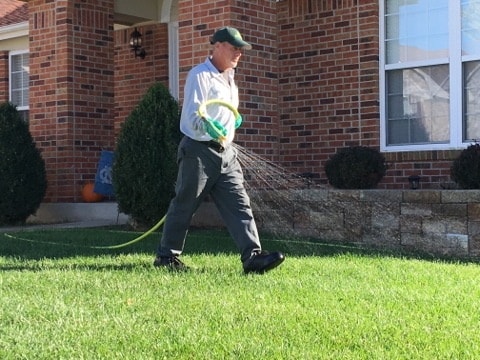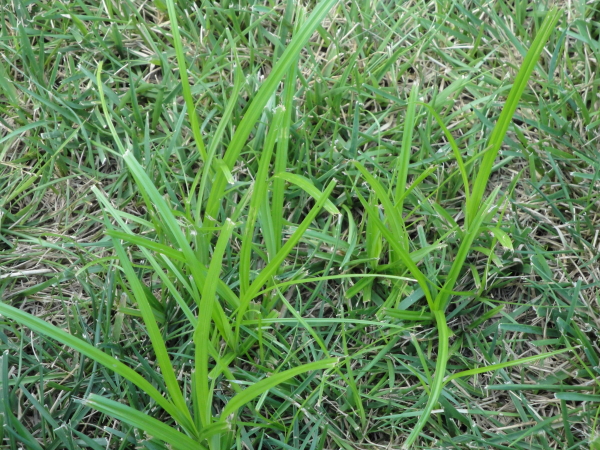Fertilizer and Weed Control
Our lawn care programs consist of scheduled applications of fertilizer and weed control. These treatments result in a healthier, lush, green, great looking lawn. Local soil conditions do not have enough nutrients to do this alone.
We provide 7 lawn care applications with balanced blends of fertilizer. We start the year with two pre-emergent barrier applications to control crabgrass. Each lawn care application includes the use of a herbicide to control broadleaf and grassy weeds, like nutsedge. A successful lawn care program requires both technical knowledge and turf management experience.
Fertilizer & Weed Control - FAQ's
Organic Lawn Care - FAQ's

Our GatorGuarantee for all customers: If you're not satisfied with our service, we'll return to your property, free of charge. And if you're still not happy, we'll refund your last application and pay you $25 for your trouble!
Recommended Services
Grub Control
Grub damage is the most common type of damage sustained in lawns throughout the United States. Customers who choose to add grub control to their scheduled services will receive it along with control of all turf feeding and subsurface feeding insects.
Aeration & Seeding
Turf grasses growing in our area benefit greatly from annual lawn aeration to reduce thatch buildup and more importantly, relieve soil compaction. This service will help improve the recycling flow of air, water, and nutrients to the root system.
Soil Analysis
A soil analysis is used to determine the soil’s pH level, available nutrients and organic matter percentage. Also a key tool when diagnosing a particular problem such as poor turf color, low seed germination, bare spots and continuous disease susceptibility.
Traditional Lawn Care FAQ's
Provided that the liquid product is mixed and agitated well per manufacturer recommendations or the granular product is applied at the correct lbs per 1k sq-ft, both are effective and can provide the same results. At TurfGator we have the capabilities to provide both liquid or granular treatments and our technicians will make the best choice in the type of treatment based on your lawns size, terrain and the needs of your lawn at the time of service.
Thatch is the grass plant's roots growing above ground level and an acceptable amount is ½ inch or less. If you mow your lawn and return the clippings to the lawn which is preferred those clippings will collect in the thatch layer but will decompose and most research has determined that clippings don't contribute to an excess thatch layer. The problem with thatch is if it gets too thick it can prevent water from soaking into the ground and prevent sufficient oxygen for the root system to grow. When thatch levels exceed ½ inch, we recommend aerating your lawn as it provides more benefits and is less destructive than a dethatcher.
No, please allow at least 2 hours for the weed control products to work before watering. As for the fertilizer it is best if your lawn receives water from irrigation or rainfall within 14 days from a treatment.
Our program is a complete 7-step lawn care program running from early March through early December. After the first application is applied, you can expect the next treatments to be scheduled approximately every 4 - 6 weeks.
Yes, the products we use are pet friendly and sustainable.
Please allow 2 hours for the weed control products to dry.
Most weeds within a lawn are characterized as broadleaf weeds and pre-emergent herbicides do not control these types of weeds. Broadleaf weeds germinate at different times during the year and our complete 7-step lawn care program effectively controls these weeds as they germinate and as they are actively growing.
Please allow 2 hours for the weed control products to dry before pets return to the lawn. As a courtesy, our technicians will announce when they arrive and allow some time for your pets to be in the lawn before they begin the treatment.
The proper name is Yellow Nutsedge, but it is also referred to by many homeowners as water grass or nut grass. Yellow Nutsedge is easily identified with its distinctive triangular shaped stem and v-shaped leaves. The leaves also have a waxy covering.
During cooler weather conditions it may take up to two weeks and during the summer it may only be a couple of hours.
Yellow Nutsedge typically grows in areas that are poorly drained and likes full sunshine. Yellow Nutsedge can be very difficult to completely eradicate. Most products on the market are labeled to only control, manage, restrain or suppress nutsedge by putting it into stress and stopping its growth for the particular growing season and there are no pre-emergent products that can prevent it from germinating. With recent advancements in post-emergent herbicides there now is a product labeled for eradication of Yellow Nutsedge. To discuss your options, please call our office at (618) 233-7600.
We provide free service calls for customers that take our complete 6-treatment lawn care program. Simply call our office at (618) 233-7600 or send us an email to our Contact Form and we will schedule a technician to revisit your lawn and spray any weeds present.
Yellow Nutsedge has a fibrous root system that develops underground rhizomes with multiple tubers or nutlets at the end of each rhizomes. Each tuber has the ability to produce a new plant, and it is impossible to pull nutsedge out of the ground with its complete root system. Therefore, in pulling the plant out of the ground the root system breaks and each tuber will produce a new plant. It is common for every one plant pulled by hand, another 10 more could sprout up and grow back.
Yes, as a courtesy to you and to avoid tracking fertilizer in your home we always blow off excess fertilizer from sidewalks, patios, driveways and streets.
If the grass plant just turns brown, but is still standing, it is more than likely just dormant. Minimize foot traffic on dormant areas as this will further stress the grass plant. If the grass plant is brown and is also lying flat to the ground, then it is dead and time to consider seeding during the fall.
For cool season grass varieties such as bluegrass and fescue the answer would be no, as fertilizing during the summer months can cause lawn diseases and can stress or burn a lawn. During the summer months, we apply weed control products (herbicides), fungicides, insecticides and organic type products which are safe during the summer months. As for warm season grass varieties such as zoysia or bermuda grass, it is just the opposite where it is best to apply fertilizer during the summer months and not during the months when the grass is dormant.
Early morning is the best as evaporation will be less than in the afternoon. Evening watering is discouraged as it can lead to lawn diseases. The 150 rule is when day temperatures and humidity added together equal 150, which is a rule of thumb that your lawn is most susceptible to lawn diseases and water on the grass plant overnight from a sprinkler system acts like a catalyst to start a disease. The summer of 2010 had a tremendous amount of rain storms that happened during the evening followed by high day temperatures and humidity, resulting in the highest amount of observed lawn diseases throughout the area in many years.
Pre-emergent controls annual weeds, such as crabgrass from germinating. This chemical barrier controls up to 90% of all weed seeds from germinating. This treatment is done typically in March and early April.
The pre-emergent barrier applied to your lawn in early spring is typically broken due to weed eaters and edgers. Also weeds need sunlight to germinate and again weed eaters and edgers expose bare dirt allowing weeds to grow. In addition, concrete tends to heat the soil along edges to warmer temperatures, compared to the rest of the lawn, which is ideal conditions for cert
Annual weed seeds such as crabgrass will begin to germinate when the ground temperature reaches 55 degrees for at least 5 or more days in a row. Typically, this occurs in our area around the 2nd week in April. We monitor the ground temperatures very closely in the spring and when the temperatures reach 55 degrees we switch to a post-emergent treatment for control of annual weeds.
Organic Lawn Care FAQ's
A traditional lawn care program has scheduled treatments of fertilizer blends of nitrogen and potassium to feed your lawn where an organic lawn care program enriches the soil thus naturally creating the same nutrients for the grass plant. The grass plant can't differentiate between synthetic fertilizers or an organic program so both are effective programs provided they are scheduled and balanced properly. For more information about the differences, please visit our more extensive blog by clicking here.
A true organic lawn care program would not typically consist of herbicide (weed control) products; however, we are able to formulate a mixed program consisting of both organic fertilizer and herbicides for pesky weeds. For most customers on this "mixed" program, they would receive the synthetic fertilizer & pre-emergent with herbicide during treatment #1, then organic fertilizer and herbicide for treatments #2, #3 and #4.
Yes, organic lawn care can be effective in maintaining a healthy and sustainable lawn. Organic lawn care focuses on using natural products and practices to promote soil health, microbial activity, and overall plant well-being. This approach can improve soil structure, water retention, and nutrient availability over time. However, it's important to note that organic lawn care methods might require more patience and consistent maintenance compared to traditional synthetic methods. Results can vary based on factors such as soil type, climate, and local conditions.
Yes, organic lawn care is generally considered safer for pets compared to traditional synthetic methods. Organic lawn care practices often involve the use of natural fertilizers, compost, and other organic materials that are less likely to contain harmful chemicals or toxins that could be harmful to pets. However, it's still important to follow the instructions for any products you use and to keep pets off treated areas until any applied products have been absorbed or washed away. As with any lawn care products, it's a good idea to consult with a veterinarian if you have specific concerns about your pets' exposure to the treated areas.
